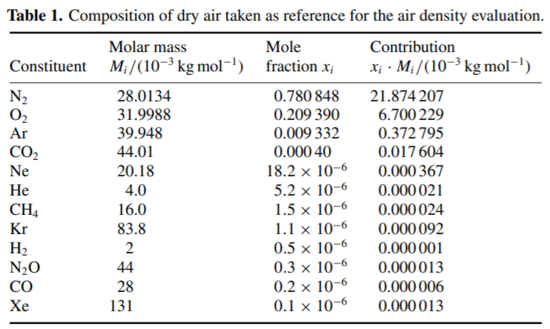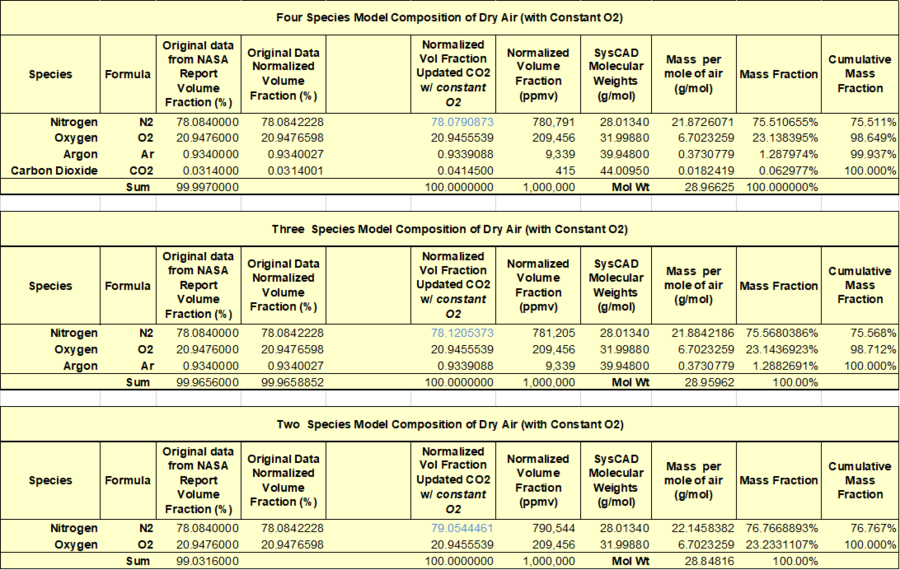Discussion: Air in Modelling
Navigation: Product Blog ➔ Discussion Pages ➔ Air in Modelling
Related Links: Plant Model - Environment
Background
In process simulation, air may be included as a chemical feedstock, a source of oxidizer for combustion, as a heat source or sink for environmental heat exchange, or to represent the air shed with respect to the dispersion of emissions. In some cases, air needs to be treated as a mixture of individual gases since its components may react in different ways with the process. In other cases, air may be considered as a non-reactive inert pseudo-species.
Composition of Air
Air is a mixture of primarily nitrogen (N2) and oxygen (O2) with small amounts of carbon dioxide (CO2) and argon (Ar) and trace amounts of some other gases. Ambient air also contains some water vapour (H2O(g)). Air without water vapour is called dry air while air which contains water vapour is called humid air.
At ambient temperatures and pressures, all of the gases in ambient air are far above their boiling points with the exception of water vapour which is often close to saturation. The relative amounts of the gases in air are virtually constant except for water vapour which can vary significantly (and carbon dioxide which is slowly increasing over time). In general, the water vapour in air is treated separately from the rest of the gases. Water vapour may be a significant mole fraction of ambient air (typically 1-2%), but can be close to 10% in extreme conditions. Psychrometric calculations usually treat dry air as if it were a single pseudo-species and consider humid air to be a mixture of water vapour and dry air.
Air in SysCAD
There are two ways that air can be included in SysCAD depending on the simulation requirements. One method is as a non-reactive pseudo-species, and the other is a detailed chemical description of air where the individual components are specified.
Non-Reactive Pseudo-Species Air
The non-reactive pseudo-species is useful for situations where there are no chemical reactions between air and the process. In most cases air can be considered an ideal gas. An air species is included with the standard SysCAD species database and has a full set of thermodynamic and transport properties taken from the NASA Glenn database that covers a wide temperature range (200–6000 K). This database is also a useful source for heat transfer and fluid flow properties data! This species is included in the default SysCAD database as Air(g).
The Air(g) species has a molecular weight calculated from the composition formula given in the NASA database[1]. Here, the composition for air has been updated to include the latest average concentration for CO2 from NOAA[2] (414.5 ppm as of April 2021). The mole fractions of other species from the original published data have been normalized to account for the increased CO2. The volume fractions and mole fractions are taken to be equal assuming ideal gas behaviour. The molecular weights for the individual species are taken from SysCAD.
Component Species Air
A detailed dry air model with individual components is also included in SysCAD. There are several options that may be configured in the Plant Model - Environment tab to define environmental air. PlantModel DryAir is available as a selection in Feeders under Feeder Operation Selection. In this form, air is represented as individual components, each of which can then be independently created or consumed, e.g. via reaction.
Ignoring trace species (molar fraction less than [math]\displaystyle{ 0.1 \times 10^{-6} }[/math]), there are a dozen normally recognized species in air. The standard dry air composition is taken from NIST CIPM-2007[3], shown in the table below.
Note that values from this table could also be used to define the composition of a standard Feeder model.
As discussed on Wikipedia, there are various datasets with generally good agreement on the composition of dry air. In the new PlantModel DryAir options we have used the NIST CIPM-2007 dataset as shown above.
Future Developments
Variable Component Dry Air
We are actively developing additional options within SysCAD to include simplified 2, 3 and 4 species models for dry air, available as additional options within the Environment tab. The simplest model for air would be a 2-species mixture of nitrogen and oxygen. 3-species air would also include argon, and 4-species air would contain carbon dioxide. If more detailed models are required, then it is straight forward to configure a makeup source with the extra species from the composition table.
The composition of these air species will be adjusted such that the mole fraction of oxygen is constant and the mole fraction of nitrogen is adjusted to account for the trace gases which are not explicitly included. This is done so that the concentration of oxygen, which is generally the reactive species in air, remains constant. The table below shows example mass and mole fractions for 2, 3 and 4 component dry air, using the NASA dataset.
Humid Air Psychrometry
We are also looking at including more detailed psychrometric SysCAD models for humidity. These would be added such that we can define a Feeder or MakeUp source for humid air with the humidity calculations built-in. This would allow you to specify any combination of temperature, humidity, dew point, wet bulb, altitude, etc. and return the partial pressure of water vapour which can then be used to adjust the air feeder.
References
- "US Standard Atmosphere" (1976) NASA-TM-74335, NOAA-S/T-1562
- "Trends in Atmospheric Carbon Dioxide" Global Monitoring Laboratory, National Oceanic & Atmospheric Administration, U.S. Department of Commerce (Accessed April 2021)
- A. Picard, R.S. Davis, M. Gläser and K. Fujii (2008), Revised formula for the density of moist air (CIPM-2007), Metrologia 45 (2008) 149–155 doi:10.1088/0026-1394/45/2/004, pg 151 Table 1
First Posted: 02 February 2022
Reference Build: 139.30270
For questions or feedback, please contact us at [email protected].


